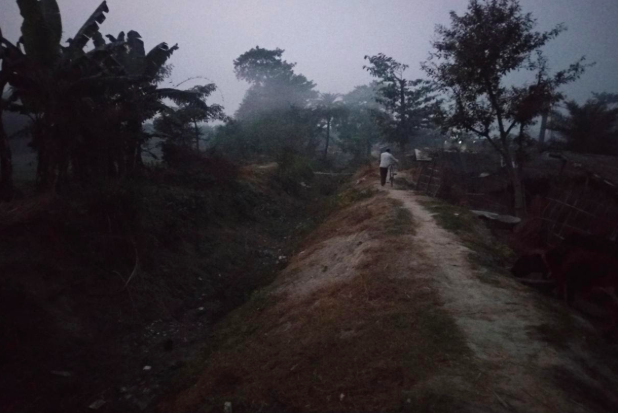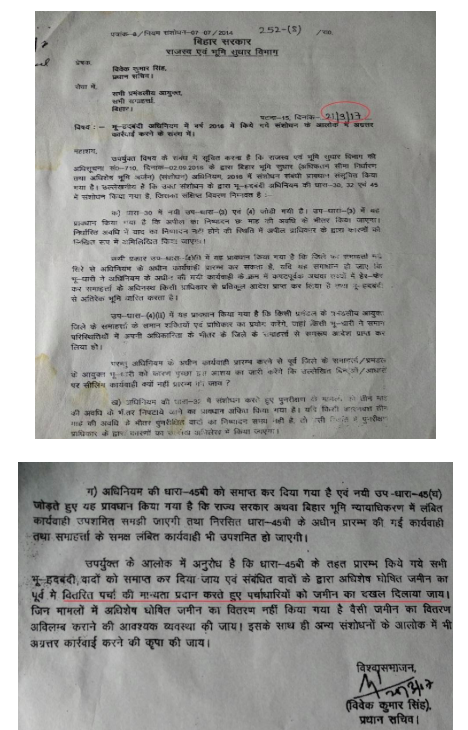Why Nitish Kumar’s Statement of Land to Landless is Just Rhetoric

Settlement on Canal Channel in Rural Bihar
In a recent review meeting on environment conservation as part of his Jal-Jeevan-Hariyali campaign, Bihar Chief Minister Nitish Kumar made an announcement for landless people dwelling near ponds, canals and rivers. He said they would either be provided with land to reside on, or with funds to purchase land so that they could build houses. He further ordered officers to expedite the identification of such people across the state. Last month, the state government projected the scheme through the formation of a ‘Human Chain’ to popularize it among the common folk.
In 2018, the CM announced a sum of Rs. 60,000 as assistance to homeless people under the Chief Minister Gram Awas Yojana scheme. This latest announcement for the landless population reminds one of Nitish Kumar’s lip-service regarding ‘Land Reforms’.
As Sir William Petty, (who was considered as the founder of modern political economy by Karl Marx) once said: “Labour is the Father and active principle of Wealth, as Lands are the Mother”. It is in this context that the issue of ‘Land to the Tiller’ needs to be raised. With 2020 marking another electoral test for lawmakers in Bihar, Nitish Kumar’s promise of implementing ‘Land Reforms’ remains broken.
After Independence, Bihar was the first state in the country to do away with the zamindari system but zamindars were not stripped of their surplus landholdings because the ruling party was full of upper caste landlords who chose a moderate, landlord-oriented path of agrarian reforms which was effectively just lip-service. In 1962, the Land Ceiling Act was passed but using loopholes, landlords evicted their tenants at large. To provide further protection to the under-raiyats and sharecroppers, the Bihar Tenancy Act of 1885 was amended in 1970 with the intention of safeguarding tenants’ interests. Additionally, to safeguard the interests of labourers and peasants, the Bihar Privileged Persons Homestead Tenancy Act and the Bihar Money Lender Act were enacted.
Bihar remains predominantly rural and agrarian with more than 90% of state’s population residing in villages and largely engaged in agriculture. As the state has a strong identity-based society, it is the social structure that determines access to resources. Among all resources, land possession is one parameter that adds value to an individual or to families and their position in society.
In Bihar, land is considered to be the determinant of the social status i.e. class and caste identity (Rich-Poor or Forward-Backward). Its relation to social acceptance is directly proportional – higher land holding through inheritance or through acquired methods gets one more respect while often ignoring the caste identity factor as well.
Land Reforms once became a much-discussed issue in political circles during Nitish Kumar’s time when a report drafted by Bihar Land Reforms Commission (2006-08), which was headed by Debrabrata Bandhopadhyay, was submitted in April 2008. The Chief Minister announced his rejection of the report in October 2009. Bandhopadhyay has been credited as the architect of land reforms in West Bengal under the Left-front government.
Deliberate dumping of Land reforms
In July 2010, the D.Bandopadhayay commission on land reforms came up with a set of suggestions to bring in a new act to protect sharecroppers, besides enacting land ceiling reforms and a computerisation of land records. Soon after the commission report, a powerful lobby mostly comprising upper caste and some backward caste people opposed a move that would give legal rights to sharecroppers.
Amid a hue and cry from within his own party and the ruling alliance i.e. JD(U)-BJP combine, Nitish conveniently backtracked from his own poll promise of land reforms. He assured the public that there would be no new law to protect sharecroppers.
The three key recommendations of the Land Reforms Commission were:
-
To do away with the present system of classification of land into six categories with ceilings varying from 15 acres for all kinds of land.
-
To allot between 0.66 acres and 1 acre of ceiling surplus land to the lowest quintile of agricultural labourers consisting of 16.68 lakh households each and assignment of at least 10 decimals of land (a decimal=100th of an acre) to shelter-less households of 5.48 lakh non-farm rural workers each.
-
The enactment of a Bataidari Act to ensure secure and heritable right of cultivation to all sharecroppers with 60% share of the produce (if the landowner bears the cost of production) or between 70% to 75% of the produce (if the bataidar bears the cost of production).
The commission concluded that there was a structural bottleneck in Bihar’s agriculture due to a very queer pattern of land ownership and the reason was not difficult to understand. According to the commission, the absence of land reforms facilitate not only a continued feudal domination within Bihar but also the assurance of a continuing supply of cheap labor from the state.
After rejecting the idea of land reforms in 2009, Nitish Kumar launched a programme to distribute three decimals to the state’s Mahadalit families in 2013. The government claimed to have identified 2.52 lakh beneficiaries under the scheme. The following year, his successor Jitan Ram Manjhi (the first Chief Minister hailing from the Musahar community) increased it to 5 decimals and also implemented the Dakhal Dehani program which provided land to Dalits and Mahadalits to build houses with ownership papers. In hindsight however, it just was a token move.
The Tribals and Mahadalits remain prime victims of land deprivation. Bihar’s tribal population is predominantly without land and remains excluded from the state government’s data records. If a large chunk of landless population finds no mention in the Census report, then Nitish’s claims of serving the landless is merely farcical.
An Unreal Social Justice
Speaking to NewsClick, Pankaj, the land-rights activist based in Bettiah who was also member of Operation Dakhal Dihani, (a state government initiative to help landless) said that as per Bihar’s revenue department, the state has close to 1,65,400 parchadharis or people who have been allotted land under the Act. He adds that their data from West Champaran is wrong too. The department claims that only 12,000 people in West Champaran are yet to get possession, but the number is 50,000.
NewsClick accessed a letter (dated 21/03/2017) by Additional Chief Secretary Revenue & Land Reforms, Vivek Kumar Singh, which was addressed to all Division Commissioners. It asked them to act upon land allotment to those who were entitled. However, close to three years later, none of the parchadharis got procession of the land.

Pic of the above mentioned order on land entitlement by Additional Chief Secretary
Land ownership and its control by the rural population determines reduction in poverty, ensuring food security with social justice in its true sense. In West Champaran alone, nearly 55,500 hectares is under illegal possession of landlords, industrialists and mills; thus land reforms remain a distant dream.
It must be noted that after the deliberate dumping of the Land Reform Commission led by D.Bandyopadhyay, the Nitish government attempted an eyewash by launching “Operation Dakhal-Dehani”, which was intended to hand over government, sarvodaya and ceiling lands to those who are entitled to get them. However, this too seems hazy on the ground.
Land Reforms in Jammu & Kashmir-
As a nationwide challenge, landlessness was dealt with political firmness in the past in states like Jammu and Kashmir and West Bengal. According to research on land reforms in the Valley by Dr. Ashish Saxena in Jammu – between the 1950s and 1970s – 70.24% of the total surplus land of 672 kanals, mainly taken away from Rajputs and Mahajans, was allotted to SC (Scheduled Caste) tenants. A radical inter-generational shift in the occupation pattern of the SCs happened in the Valley as a result, with the number increasing from 0 to 47.1% in the space of two generations in the region.
According to Haseeb A. Dabru, the economic enfranchisement of the poorest in J&K which led to to more than 25% of the household earnings in the state was due to the near absence of landless labour and ownership of land.
Emphatic propaganda by the Bihar government of serving the deprived failed miserably in showing a lowering of poverty in terms of reducing landlessness. Lessons on egalitarianism from J&K in rehabilitating the needy was just a systemic exploitative version of development that deepened roots of the neo-feudal order while giving no space to an effective agrarian transition.
Prior regimes also did less to address ‘land to the tiller’. The regime of Karpoori Thakur (who became chief minister in 1977) instilled hope in people for betterment but Thakur, surrounded by the same landowning upper and dominant castes, could not do much on the issue of land reforms. In 1980, when the Congress came back to power in the state, all hopes of change faded away because the state was busy feeding upper-caste alliances. In the 90s, when the reigns of Bihar landed up in the hands of Lalu Yadav, people pinned their hopes on his much-hyped tenure which promised social justice. Operation Todermal was launched by the then minister for revenue and land, Inder Singh Namdhari, and was aimed at detecting surplus land concealed by feudal landlords and distributing it among the needy within a time-frame.
During his regime, Nitish just presented a mirage of development and social justice for landless people. His narrative of sushashan came and went but he owes more accountability on account of his tenure being a decade and a half long. Meanwhile Bihar remains seated on a debris of the broken promise of land reforms.
Get the latest reports & analysis with people's perspective on Protests, movements & deep analytical videos, discussions of the current affairs in your Telegram app. Subscribe to NewsClick's Telegram channel & get Real-Time updates on stories, as they get published on our website.
























